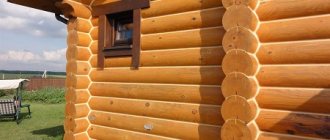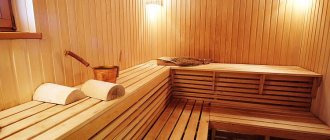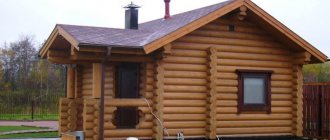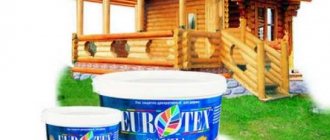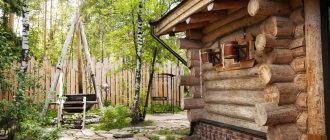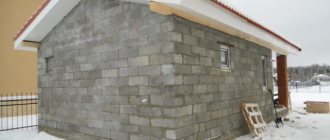Steaming in a bathhouse is an original Russian tradition. But in order for the steam room to be truly cozy, and to spend time in it pleasant and comfortable, it is necessary not only to build it correctly, but also to protect it from heat leakage, moisture, wind, and cold air. Traditionally, the bathhouse was insulated with caulk, but nowadays this outdated method of insulation is used less and less. Today, many people prefer modern technologies for sealing wooden houses using special sealants. However, a bathhouse is a room with a special microclimate, and not every product can be used in extreme temperatures. In this review we will talk about how to choose a sealant for a bathhouse and how to apply it.
Adhesive sealant for seams, gray
CEMMIX Adhesive-sealant for seams is a one-component polyurethane sealant for sealing various seams, junctions of steps and walls, entry of pipes and ventilation systems and rigid-elastic gluing of various materials.
More details
Why do you need to seal log houses?
Sealant for wooden houses solves many problems that often arise in wooden houses. Consider the effect of weather on wooden structures.
The formation of cracks or insufficient sealing of log houses leads to the destruction of the tree. Due to contact with precipitation in the form of showers, fog, and increased levels of moisture in the air, mold appears, which provokes rotting. This negatively affects the service life of the building.
Sealant for log houses protects walls from blowing. This is an additional advantage during the cold season of the year.
Adhesive sealant for seams, brown
CEMMIX Adhesive-sealant for seams is a one-component polyurethane sealant for sealing various seams, junctions of steps and walls, entry of pipes and ventilation systems and rigid-elastic gluing of various materials.
More details
But today, when the chemical industry develops and produces a huge amount of a wide variety of materials, it makes sense to change traditions a little, especially since caulking has no other advantages, and there are many disadvantages:
- this is a labor-intensive, lengthy process that requires certain qualifications;
- the caulk needs to be renewed periodically (every 3–5 years), because the materials cake;
- During the caulking process, the height of the building increases, which leads to the appearance of cracks around window and door frames.
Where in the bathhouse is sealing required?
In a wooden bathhouse, several areas require sealing:
- interventional joints;
- chimney;
- places of passage of communications;
- junctions of window and door frames;
- junction of the floor to the walls, seams of the tile floor.
It is advisable to fill all these areas with high-quality modern sealants, which, with the right sealant chosen, will be easier, faster and more reliable than caulking a bathhouse.
Let's consider what requirements a sealant suitable for baths must meet:
- environmental safety, absence of toxic fumes (in this case plays an important role);
- resistance to high and low temperatures;
- high adhesion to porous materials - wood, as well as metal, glass and other materials used in construction;
- moisture resistance;
- resistance to solar radiation (since the sealant is also used for external seams);
- high elasticity (which is important when working with wood).
Not the least important role is played by such characteristics as ease of use without special devices (owners often build baths themselves) and the ability, if desired, to paint the seam.
What should not be used in the steam room
You should not use silicone or polyurethane compounds for this room. They often contain substances that are released by temperature changes. Often such compositions are prohibited for use in interior spaces.
What sealant should I buy for treating a steam room? One that can easily withstand all the problems and features of the room and will last longer than standard compounds.
The professional staff of “TORVENS” will cope with the task
What types of sealants are there, and what sealants can be chosen for a bath?
Today, there are different types of sealants on the market depending on their main components:
- acrylic;
- silicone;
- rubber;
- thiokol;
- polyurethane.
Acrylic sealants are environmentally friendly and widely used for working with wood. However, instability to temperature changes and constant humidity makes them unsuitable for use in a bathhouse.
Silicone sealants are very elastic, waterproof, work in a wide temperature range (from –60° C to +300° C), but do not perform very well when working with wood. During operation, the seams of wooden structures can stretch and contract. While silicone sealant works well when stretched, it may bubble when compressed.
Butyl rubber sealants are not suitable for high temperatures.
Thiokol sealants require certain skills in application, and therefore are not suitable for independent work.
Polyurethane sealants are the best choice for baths. Let's look at why this is so, using the example of Cemmix one-component polyurethane adhesive-sealant for seams.
The first thing worth noting is that this is a one-component adhesive-sealant, which means that it comes ready to use and does not require mixing of several components; It can be used both for filling seams and for gluing various surfaces, that is, the material is universal and easy to use.
Cemmix joint adhesive sealant demonstrates the following characteristics:
- environmental safety, absence of harmful fumes;
- excellent adhesion to different types of building materials, including porous ones (wood);
- no shrinkage during the curing process;
- high elasticity;
- waterproof;
- resistance to solar radiation and chemicals;
- heat resistance and resistance to temperature fluctuations;
- the ability to apply sealant at sub-zero temperatures and on wet surfaces;
- resistance to fungus and mold;
- high mechanical strength;
- service life with retention of properties for more than 10 years.
It should also be noted that the polymerization of Cemmix adhesive-sealant for seams occurs under the influence of air moisture at a high speed (1–2 mm per day). Cemmix adhesive-sealant for seams is available in four shades, but if necessary, the seams can be painted after first testing for compatibility with the selected paint materials.
Thus, Cemmix adhesive-sealant for seams, due to its properties, is optimally suited for sealing seams and joints in baths and steam rooms, providing reliable results for many years of operation.
High-quality sealing of seams in a bath using Cemmix Adhesive-Sealant for Seams allows you to beautifully process seams and joints, reduce the cost of heating a bath, and prevent the appearance of fungus and mold.
Why insulate the seams of a steam room
Insulating the walls of a bathhouse or sauna helps maintain the necessary microclimate of the room, reduce heat loss and create suitable temperature conditions for the steam room. If the seams are not sealed properly, this increases fuel consumption, increases heat loss from the structure and leads to leakage and the appearance of mold and putrefactive processes. Insulating the seams helps create tightness and the conditions necessary for the normal functioning of the bathhouse and steam room. For this purpose, various methods are used, in particular, caulk and sealants.
Adhesive sealant for seams white
CEMMIX Adhesive-sealant for seams is a one-component polyurethane sealant for sealing various seams, junctions of steps and walls, entry of pipes and ventilation systems and rigid-elastic gluing of various materials.
More details
“Warm seam” application technology: how is it?
Warm joint wood sealant is applied using the same technology. This can only be done with a special pistol.
Using this technology, insulation and cord are placed under the sealant. With it, you will ensure effective sealing that will last for decades.
Recommendations from the experts
When buying sealant for a wooden house in Moscow, consider the principle of its application. Carefully study the main characteristics of the composition. The approximate sequence of all work will depend on them.
Do not trust untested products from unknown manufacturers. Their quality is rarely high. The market is replete with Chinese counterfeits. Therefore, be careful when purchasing, not losing sight of any embarrassing little detail.
We recommend watching a video on how to properly work with sealants for log houses. Here are some important recommendations for effectively filling joints in a wooden house:
Do you know another way of working from personal experience? Share it in the comments to the article to help other readers choose the most effective one.
Adhesive sealant for seams black
CEMMIX Adhesive-sealant for seams is a one-component polyurethane sealant for sealing various seams, junctions of steps and walls, entry of pipes and ventilation systems and rigid-elastic gluing of various materials.
More details
Briefly about the main thing
Silicone sealant is used as an elastic, moisture-proof filler for seams and joints between mineral, wood, plastic, metal, and glass substrates.
The limitation of relatively weak adhesion is polymeric materials.
Manufacturers use various additives that affect the technical characteristics of the finished product and its scope of application.
There are silicone sealants that are acceptable for use as moisture-resistant adhesives.
Ratings 0
Adhesive sealant for seams, gray
CEMMIX Adhesive-sealant for seams is a one-component polyurethane sealant for sealing various seams, junctions of steps and walls, entry of pipes and ventilation systems and rigid-elastic gluing of various materials.
More details
average cost
The price of the compositions depends on many factors, such as the form of release, country of production, volume, brand, type of sealant. Average prices for different formulations are shown in the table:
| Manufacturer country | Sealant brand | Release form | Volume | Price |
| Acrylic sealants | ||||
| Germany | Remmers ACRYL 100 | Cartridge tube | 600 ml | 550 rub. |
| America | Perma-Chink | Cartridge tube Bucket | 325 ml 19 l | 1000 rub. 31,000 rub. |
| Russia | Eurotex | Bucket | 25 kg | 6300 rub. |
| Silicone sealants | ||||
| Spain | QUILOSA Sintesel Madera | Cartridge | 280 ml | 320 rub. |
| Russia | Ultima universal | Cartridge | 280 ml | 250 rub. |
| Bitumen sealants | ||||
| Finland | Makroflex | Cartridge | 300 ml | 230 rub. |
| Estonia | KRAFTOOL 41261 | Plastic tube | 300 ml | 260 rub. |
| Polyurethane sealants | ||||
| Russia | Rustil two-component | Bucket | 7 kg | 1200 rub. |
| Belgium | Soudal one-component | Cartridge | 300 ml | 450 rub. |
| Switzerland | Sikaflex Construction+ | Sausages | 600 ml | 500 rub. |
Adhesive sealant for seams, brown
CEMMIX Adhesive-sealant for seams is a one-component polyurethane sealant for sealing various seams, junctions of steps and walls, entry of pipes and ventilation systems and rigid-elastic gluing of various materials.
More details
Even a non-specialist can use Cemmix Seam Adhesive-Sealant, and a professional result will be guaranteed if the application technology is followed:
- Clean the surfaces from dirt, oils, and old sealant. It is recommended to prime porous surfaces (if in doubt, perform an adhesion test).
- An important requirement for the construction of seams is that they must have only two contact surfaces, otherwise the seam will not be strong. Therefore, at the mouth of the seam, a cord of closed-cell polyethylene foam is placed, which does not have adhesion to Cemmix seam sealant.
- It is recommended to protect the surfaces around the seam with masking tape so that the edges of the seam are even.
- The width of the seam should be twice its depth. This is important in order to ensure uniform polymerization of the material. Otherwise, one of the sides may tear off and the sealant may leak.
- Cemmix adhesive-sealant for seams is applied using a construction gun with a measured movement in one direction.
- Within 15 minutes after application, the sealant can be smoothed with a spatula, moistening it with soapy water and removing excess.
- The masking tape is removed immediately after smoothing the seam. At this time, you can still remove excess sealant. When it hardens, it will have to be cut down.
- During the polymerization process, the sealant remains soft, so it is not recommended to subject it to mechanical stress for several days.
Our favorite baths become even more comfortable and durable, and also take on a stylish, modern look if we apply the right sealant. The optimal choice for sealing all important areas of the bathhouse is Cemmix adhesive-sealant for seams - a universal, reliable, easy-to-use material. You can buy Cemmix adhesive-sealant for seams wholesale from the manufacturer and in retail chains, for example, in Leroy Merlin, as well as in online stores.
You can buy CemPlast, CemBase CEMMIX without leaving your home, with discounts from 5 to 33%!!!!
Buy on Ozon
Buy on Yandex.Market
Buy on Wildberries
Buy at Leroy Merlin
Or you can find the nearest official dealer in your region on our map
← Why is waterproofing of open balconies needed, and how is it done?
How to waterproof a basement floor from groundwater →
Return to list
Comments
Professional sealing services for wooden houses
offers its services for insulating houses made of timber and logs located in Moscow, the Moscow region and surrounding areas.
We are official dealers of manufacturers producing premium sealants Remmers, Ramsauer, Oliva and others. Thanks to this, our customers can order sealing with branded products on favorable terms.
In our company, the main emphasis is on the quality of the services provided. We carry out triple quality control of the work performed. Masters undergo regular training and advanced training.
To contact us, go to the “Contacts” page, where you will find our contact details and the form for submitting an application.
Calculate the cost of painting and insulating your home right now
Select types of work:
Select materials:
News
We are always ready to help
Cemmix has opened a free hotline
to help you with any questions related to construction using concrete additives. Call and ask, our consultants are always ready to help!
Hyperplasticizer
Hyperplasticizers are a new type of plasticizing additives for concrete, ensuring the mobility of the mixture above P5. In addition to plasticity, they increase the water resistance and frost resistance of concrete by 2-3 times.
Let's support domestic producers
If we analyze the sealant market, then, traditionally, products from domestic manufacturers will be more attractive due to their low cost. You can buy one package of Russian sealant for 350 rubles. for 1 kg. As for American analogues, they cost about 3 times more. This should not be surprising, since this price includes customs duties, transportation costs and unreasonably inflated trade margins.
Domestic manufacturers use American and German polymers to produce sealant In addition, we should not forget that Russian sealants were initially created for use in harsh Russian conditions. Therefore, it is difficult to name at least one good reason to give preference to foreign products rather than high-quality sealants from Russian companies.
What is the best way to seal the cracks between logs: caulk or sealant (installation secrets)
After the construction of log houses, it is necessary to seal the gaps between the logs.
Previously, they used moss, then tow, flax wool and jute. You need to be able to work with moss and know how to do everything correctly. Not everyone has knowledge of the old masters. Therefore, jute fabric, tow, linen batting and more modern insulation - acrylic-based polymer sealant - are more often used.
Today we will compare sealant and caulk. Which is better, more durable and more effective?
How to seal gaps between logs - consider traditional materials
When it comes to finishing the seams between beams or logs, literature alone will not be enough, since a dozen books will provide the same number of caulking options for your consideration. Of course, deliberately false information rarely appears on the pages of reference books, but it still happens, and identifying it among other data is quite difficult.
The most reliable advice on how to seal cracks between logs will only be given by an experienced craftsman, or at least a person who has actually tried what he is talking about. And, interestingly, many agree that moss is one of the most effective materials for caulking. Often on the outskirts of swamps you can see a whole carpet of sphagnum, which, while still wet, easily packs into the joints between the crowns.
Only the kind of caulk that can be called high-quality is one in which a sharp awl fits into the gap between the logs no less hard than into the wood.
A more common and equally environmentally friendly way to seal cracks is to fill them with tow, coated with plaster or cement mortar, or simply compact this consumable material, which is accessible to everyone, without any additives. You can use hemp or jute fiber instead. The difference between hemp and tow is insignificant - the first is a derivative of flax, less often hemp, the second is obtained only from hemp.
